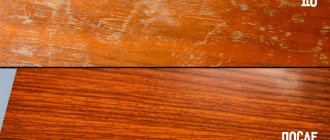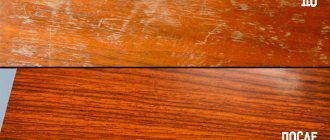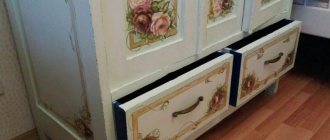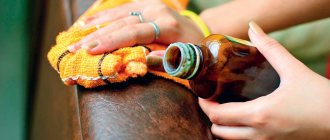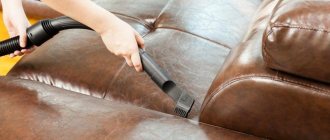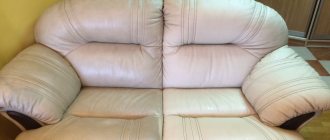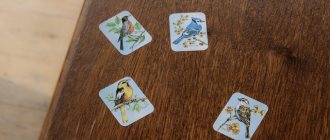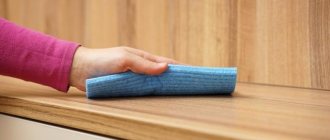The material used to repair and add freshness to wooden surfaces is furniture wax. The most expensive and high-quality wooden furniture loses its luster and beauty over time. The presence of children and pets in the house accelerates the aging process. To give your interior a fresh look, you can use special products. In this article we will look at how to properly use markers and wax for furniture restoration, and find out what types of this product are on the market.
Pros and cons of using
Unlike other products, the mixture does not lie on the surface of the wood, but penetrates its internal structure. The texture of the wood does not deteriorate, and the heat is retained for a long time. In addition, wax has the following advantages:
- The surface acquires a natural velvety feel to the touch; there is no glossy polishing.
- Furniture made from natural wood will sparkle with new and expressive colors.
- The range is presented in various tinting options: any furniture will harmoniously fit into the interior.
- In terms of its external composition, wax is a thick, dense mass that completely fills chips, cracks, scratches and other mechanical flaws.
There are many more pros than cons. The main disadvantages include the low protective level compared to the same varnish. It is also impossible to completely disguise marks and stains that form as a result of the harmful effects of moisture and sunlight.
Properties of protective coating
First, let's find out what liquid wood wax is. Among its advantages, one cannot fail to note the following:
- Environmentally friendly.
- Easy to apply to wood surfaces.
- If part of the surface has been replaced, then wax will help smooth and blur the boundaries of the fresh part and level the visible surface.
- Waxed surfaces are easy to clean or clean, including using wet methods.
- After some time, you can give the surface a new shade by covering it with a composition with a different paint.
- A wax coating can mask small scratches or other defects on the surface.
- After waxing, water will no longer be absorbed into the wood.
- All sorts of insects - parasites or bacteria and fungi - will not get to it either.
In general, the wax composition is quite universal, so it is suitable for protecting floors, furniture, dishes, walls, etc.
Homemade wax
After reading this publication, you can learn how to make homemade modeling wax. We will offer you a recipe, as well as useful manufacturing tips.
- For its base, various oils of natural origin are taken.
- Olive oil.
- For 2 tablespoons of beeswax, take 7 tablespoons of olive oil.
- Crumble the wax and knead it with a spoon.
- Add oil to it and heat it in a water bath. Then stir until it cools completely.
The prepared wax should be stored in a glass jar and covered. This wax retains its beneficial properties for a year, then you will need to prepare it again.
Wax with a base of jojoba oil.
This is such an environmentally friendly material that it can be used to treat both dishes and toys.
- Mix beeswax (50 mg) with jojoba oil (150 g). You can take other quantities of ingredients, but their ratio should be 1 to 3.
- Grind the wax and heat it in a water bath, add oil.
- Stir the mixture until it cools completely.
- This composition is stored in a glass jar with a lid for 2 years.
The wax base is linseed oil.
The technology is basically the same, but the ratio is slightly different:
- For a couple of tablespoons of wax, take 6-8 tablespoons of oil. To change the thickness of the mass, adjust the amount of wax.
- You can add paint of the desired color to the composition.
- Adding a drier to the mixture will speed up the drying of the wax on the surface of the wood.
- The composition is stored in a glass jar in a dark place for about 1 year.
Carnauba wax composition.
The main component for this composition is extracted from the leaves of the North American palm tree and appears as flakes. If ordinary waxes melt at 35 degrees, then carnauba wax is more heat-resistant. To apply it to wood, the composition must be turned into mastic. With various additives it becomes more plastic.
- The cereal is placed in a metal bowl and heated slowly with a lid.
- Pour in hemp-linseed oil (except vegetable oil) in a volume twice as large as the wax and wait until the wax melts.
- Stir the mixture until it cools completely and pour it into a glass jar with a lid for storage.
- If your mastic is very thick, you need to melt it again and add more oil. And if a film was noticed during storage, it will need to be removed before using the composition.
Types of material
There are many types of wax-based materials. The modern market offers the buyer the following varieties:
- Soft. Experts recommend using it to restore furniture and remove chips, dents and cracks. The restored surface can easily withstand physical stress. In addition to wood, the soft type is ideal for laminated flooring. No preparatory work is required; the mixture is sold ready-made. Using a plastic spatula, a certain amount of mass is applied to the dent or crack. If you need to create a specific color, several shades can be mixed with each other. Excess mass is removed with a spatula.
- Solid. The material has a dense structure. The solid consistency is ideal for both internal and external restorations. Easily copes with your favorite surface imperfections. Use a soldering iron to melt the wax. After this, it is applied to the damaged wooden structure. Within a matter of seconds, the mixture is completely absorbed into the layer. Excess is removed with a spatula.
- Liquid. It is customary to add synthetic components to its composition. Thanks to this, the consistency becomes liquid. This mass is easily applied to the surface using a brush or soft brush. It completely penetrates scratches and cracks, and is presented in stores as a creamy structure. It will take a minimum amount of time for the liquid to dry completely.
All varieties contain the following natural ingredients:
- Essential oils of coniferous plants;
- Tree resin;
- Drying oil;
- Beeswax;
- Olive, linseed oil.
In everyday life it is convenient to use a wax pencil for furniture - from scratches. It is available in a wide range of colors and has water-repellent properties. After its impact, the furniture looks like new. Used on varnished and laminated surfaces. Using furniture wax is very simple and convenient.
Basic properties and purpose
Modern cabinets and chests of drawers are subject to mechanical damage as a result of numerous moves and rearrangements, tables lose their attractiveness due to careless handling, so furniture wax remains in demand for minor repairs and care of products made of natural wood, laminate, parquet, chipboard and fiberboard. It is also suitable for repairing chips and cracks in window frames and doors. Furniture wax is used to treat panels, picture frames, wooden boxes and stair railings.
In addition to beeswax, the composition may contain synthetic resins, which give it greater durability, coloring pigment, and natural oils (for example, olive or linseed). Oil with wax provides light protection from moisture and a pleasant matte shine to wooden elements. The main purpose of the product is the renewal and restoration of products. A properly selected composition performs several functions at once:
- masks chips, scratches, small cracks;
- renews the surface of products, adding shine to them and emphasizing the texture of the wood;
- protects furniture from external influences, penetrating deeply into the structure of the material;
- used to enhance or slightly change the shade of wood;
- has antistatic properties, prevents dust from settling.
Products based on natural wax are very gentle on the texture of wood. They cannot radically change the color; they simply renew even heavily worn surfaces and give them a presentable appearance.
Manufacturers offer furniture wax for interior and exterior use; this should be taken into account when choosing a composition.
Varieties for interior use are less resistant to sunlight and moisture. The products differ in the form of release; it can be a hard bar, a pencil, or soft compositions with a texture reminiscent of Vaseline. Furniture wax can be colorless or tinted. In the second case, its shade should be as close as possible to the color of the surface being treated.
Rules of application
Short rules will help an amateur use furniture wax correctly and complete restoration work without errors:
- Surface preparation. For uniform impregnation, the pores of the wood must be open. If the furniture is factory-made and not covered with paint and varnish, then no preparation is required. If the surface is varnished, then to remove the top layer you will need the help of a solvent. They should treat the surface several times until the remaining varnish is removed. It is necessary to go through the direction of the fibers with sanding material.
- Applying wax. First you need to decide on the variety. The preparation of the necessary tools for the job depends on this. The soft look is rubbed in the direction of the wood grain using a thick cloth. If the choice fell on the hard type, then a spatula will be required to evenly rub into the surface. After applying the composition, the structure should be left alone for an hour. Then the excess wax mass is removed. To achieve a glossy effect, treat the wooden layer again.
Features of varieties
Furniture wax of soft and hard grades has its own characteristics.
Soft
Use it to get rid of scratches, chips, cracks and dents. Even if there are large broken edges or holes from self-tapping screws, this remedy will be effective.
In order to apply it yourself, you must follow these recommendations:
- To restore objects, the product must be rubbed in thoroughly.
- Use an edge knife to apply wax to the edges. The missing piece of furniture should also be formed from it. You need to level the surface using a spatula.
- Excess pieces of material are cut off with a knife. Smooth the plastic surface with a corner.
- You can use a felt cloth to polish the repaired surface.
Using such a pencil, you can restore patterns on furniture.
Solid
Such wax pencils have the same purpose as soft ones.
They differ in that:
- have a high degree of protection against mechanical damage,
- can be used for DIY restoration, but only after melting,
- their price is higher than soft ones,
- they are not easy to find,
- There are few color varieties.
The features of removing scratches with your own hands using this product are the same as in the case of soft ones. But a hard pencil must first be melted using a lighter, blowtorch or torch.
Self-production
The recipe is simple. Many experts prepare wax for furniture with their own hands. The solution is prepared in a water bath. To do this, you need to combine beeswax with turpentine. The first component must be thoroughly chopped with a knife, then placed in a container with turpentine. It should be half as much as beeswax. During the cooking process, the mixture should completely melt. To add thickness, the remaining wax is added to the finished solution. The main safety rule is careful handling of turpentine. It can easily ignite, so you should not keep it on fire for a long time.
As soon as the finished mixture has cooled, evaluate the degree of thickness. To make the solution more liquid, you need to place the container on the fire again and add turpentine. The resulting wax is stored in closed packaging.
During moving or long-term use of furniture, chips, cracks or scratches may appear. Replacing cabinet elements will entail serious financial expenses, and throwing furniture into a landfill can be a pity or impractical. Wax comes to the rescue, which easily gives the furniture its original appearance.
In order to learn how to use furniture wax, you do not need to have much experience, it is enough to learn the basic points of the work. This will allow you not to use paid services of specialists.
During the process of moving or using furniture, cracks, chips and scratches may appear. Sometimes finances do not allow you to buy a new one, and sometimes it is impractical because the furniture itself is in excellent condition. A professional product – furniture wax – will help in correcting damage.
This material is used in its natural form or in the form of special mixtures.
This universal product, designed for processing wooden products, can be used on both clean and laminated and varnished surfaces.
Wax can give a tree new life, improve its quality characteristics and appearance.
Such a mixture cannot be replaced with paraffin or other analogues painted in the desired color, since its texture and properties are different. This product is securely fixed in cracks and does not wash out.
Wax practically does not oxidize, and therefore is able to retain its properties for hundreds and even thousands of years.
Alternative options
If you don’t have time to run for furniture wax, don’t have the funds to buy it, and don’t even have the desire to cook it yourself, use other folk remedies.
Alternative options for restoring a wooden surface:
- Grandmothers used to use walnuts to cover up damage and scratches on furniture. A cut of the kernel was rubbed on the damaged area for several minutes. The treated area was then wiped with a dry cloth to remove any remaining nut oil. The process is completed by sanding and coating with clear varnish. You don't have to buy a special polish; you can use it on your nails.
- To make the damage disappear on its own, it is recommended to use mayonnaise. It also contains oils and fats, which cause the wood to swell. Thus, the crack heals itself. The only drawback of this technology is the duration. For mayonnaise to work, it must be left on the damaged area for two days.
- For dark furniture, you can use cool tea leaves. Prepare a solution to match the color of the table; if necessary, dilute with water to obtain the desired shade. Apply tea leaves to the damaged area, let it soak in, then pour a little more, and so on until the scratch is hidden and the desired shade is achieved.
- An ideal alternative is ground coffee. It is poured into the scratch, the excess is removed with napkins, and the damage itself is hidden with varnish.
As you can see, you don’t have to spend money on wax or prepare it yourself. Everything can be solved at home, without major financial expenses.
Moreover, every housewife has such folk remedies; you don’t even need to run to the store for them.
Types of furniture wax
Mixtures are divided into the following types:
Soft wax makes wood surfaces smooth and provides the desired shade to the wood texture.
This wax is preheated to make the wood material softer and the application better.
Soft is used if you want to update the appearance of furniture and give it a more attractive appearance, remove minor scratches and small cracks, repair shallow dents and chips.
This type of product is quite easy to use.
Before applying it, it is necessary to prepare the area for treatment - wipe it dry, remove any remaining paint or varnish, if any. Then the product is applied by rubbing in the required amount and left for 25 minutes.
The main advantage of this coating is that the wax penetrates the wood rather than remaining on the surface.
The excess is removed with a knife, and the treated area is polished with a felt rag or cotton napkin. If the scratches are significant, the holding time can be increased.
This type has a richer palette of colors than the solid type.
Restoration of laminated surfaces
If you need to put the laminated surface in order, then you should familiarize yourself with the following recipe. To prepare it, prepare the following ingredients:
- 100 grams of wax; 25 grams of rosin; 50 grams of turpentine; propolis.
- Melt the substance in a water bath. After dissolution, add rosin. Carefully pour in the turpentine. To make the solution acquire a pleasant smell, you can add a little propolis to it. Pour into a container and cool. Apply with a soft cloth.
Thanks to this processing you will receive:
- water-repellent surface; disguised scratches and minor defects; filled joints; beautiful matte shine; pleasant aroma.
Advantages and disadvantages of use
Professional wax is an excellent solution if you want to update the appearance of furniture, and, objectively, this product has much more advantages than disadvantages.
In addition, its use can replace varnish, which in some cases contains harmful substances and has an unpleasant odor.
Among its advantages it is worth noting:
- Good moisture-repellent properties;
- Removing chips, cracks, filling joints and giving furniture a new look;
- Nice shine;
Wood coated with wax becomes silky and shiny.
With the help of wax, the wood texture is perfectly restored, abrasions and various types of defects are removed, the color becomes richer and softer.
Among the disadvantages of using such a product are the low protective properties for furniture compared to varnish. In addition, they cannot “cover up spots” that appear under the influence of sunlight, moisture and other factors.
If there are stains, then you must first bleach the wooden surface.
How to choose the right one
The choice of restoration product depends on the color, type and composition. The color palette is quite impressive.
Finding a suitable color will not be difficult.
Almost all types are based on the same composition containing natural substances:
- Wax (beeswax or carnauba);
- Oils (olive, linseed, etc.);
- Coniferous esters;
- Wood resin;
- Drying oil.
To give the required consistency and properties, artificial solvents, UV filters and other additives are added.
The choice of consistency depends on the area of the damaged surface and the depth of the cracks. Liquid wax is suitable for shallow multiple scratches.
It is better to choose a solid mixture if the chips and cracks are large and require careful restoration.
Apply the wax by simply pressing it into the surface and then rub it with a spatula.
Soft is valued for its rich color palette and ease of use.
The color is quite stable and will not fade over time.
Wax comes in different forms. To remove minor damage, it will be convenient to purchase a wax pencil.
Wax pencil is the simplest and most economical solution for furniture restoration.
To process a large area, it is better to purchase bulk containers.
Characteristic
There are several types of wax. It can be soft or hard. You can prepare the product yourself.
This wax is used only for restoring furniture. It is used if the material has a lot of scratches, cracks, chips and abrasions.
Soft
This type of furniture wax is recommended for use if the damage is deep. The soft composition ideally masks chips and will save you from deep scratches.
It does not need to be diluted or mixed with any substance. Bought it in a store and use it in the same form to hide damage.
How to use wax:
- Put on gloves and take a plastic spatula.
- Apply the product to the desired areas with a spatula so that not a trace remains of scratches.
- Use it to remove any remaining substance. Level the surface.
- The soft composition dries in 20 minutes. After this time, all that remains is to polish the furniture.
To keep tables and cabinets in proper shape, they should be varnished after the wax has completely dried.
If the damage is deep, apply the product in several layers. Each of them must be thoroughly dried before being polished and varnished.
You can use soft wax simply to renew wooden material. It is used for the restoration of cabinets, bedside tables, tables and even for flooring, for example, laminate.
Solid
If the house is undergoing renovation in full swing, and in the process of moving furniture you notice scratches appearing on it or on the floor, do not wait, and immediately get rid of them using hard wax.
- It does an excellent job of removing scratches.
- Perfectly masks minor abrasions.
- It also restores serious defects.
Wax pencils are easier to use than soft mixture. They are sold in different colors, so choosing the right product will not be difficult.
Be sure to wear gloves when using them. Substances used to make wax crayons can adversely affect the skin of your hands, causing serious rashes or redness.
Don't throw away the leftovers, but save them. If stored correctly, they can still be used.
How to use wax crayons for furniture:
- Melt it down. To do this, use a soldering iron, a gas torch or a regular lighter.
- Then cool a little so that the adhesion to wooden furniture is better and immediately apply to the damaged area.
- Remove any remaining product with a utility knife or plastic spatula.
- Wait for it to dry and paint the surface with varnish.
Wax pencil is easy to use but is more expensive than the soft stuff. There are no other differences.
There is also another remedy. It comes in the form of crayons that are sold in hardware stores. They can be oval or rectangular. They are the easiest to use because you don't need to melt them. With crayons they simply paint over the damaged surface and varnish it. They are sold in different colors.
How to use
In order for the product to be well absorbed into the wood, it is necessary to prepare the area to be restored. To do this, you need to remove dust. The coating should be removed from a varnished or polished surface using a solvent.
If necessary, the wood is bleached.
Depending on the type of wax, various tools are used for its application: spatula, brush, brush, etc. The finished composition is applied in a very thin and even layer. It is better to leave any mixture on the surface for at least an hour for better adhesion and hardening. Excess is removed with a knife and polished with a napkin.
To achieve a beautiful shine, the treatment must be carried out twice.
Preparing the tree
To restore wooden furniture, you will need to prepare it well. To achieve the maximum effect from wax, cabinets, bedside tables and other products that require restoration must be cleaned.
Only after careful preparation will the product lie in an even layer.
You will need to do the following:
- Treat the surface with a solvent; it is important to remove all or part of the varnish coating.
- Then take the sandpaper and go over the cleaned areas.
- Then go over the furniture with a soft, lint-free cloth and begin applying the wax.
For dark wooden furniture, use a dark product; if they are white or beige, use a light product. Be careful when choosing.
The technology for working with different types of wax differs significantly. However, having familiarized yourself with the methodology for their use, questions about their use should not arise.
The hard and soft composition is easy to apply, just like one prepared by hand. The main thing is to carry out preparatory measures for the tree, and then use the purchased product.
Waxing furniture: advantages and disadvantages
Waxing furniture is a type of finishing that has been known for many centuries. As a rule, the surface of the products is coated with wax, after which it acquires a slight shine and increased resistance to moisture.
Benefits of waxing furniture
In addition, wax emphasizes the color of the wood, although not as clearly as, for example, oil. Also, this method of processing furniture can complement and smooth out minor defects.
Generally, waxing works great on cabinets or dressers.
Moreover, wax works as an antistatic agent, which helps prevent large amounts of dust from settling on furniture.
Some disadvantages of waxing furniture
Of course, wax is not as durable as, for example, varnish, so it should be renewed once a year, in addition, it is recommended to completely remove all layers of wax every few years and wax again.
It is not advisable to use this treatment on heavily used furniture, such as chairs, tables, kitchen countertops, as the surface will wear off quickly.
Also, the disadvantages of wax include its sensitivity to high temperatures, so it is not recommended to place hot objects on such surfaces, and it is also undesirable to plan furniture close to radiators or a fireplace.
Work methodology
Once the wax pencil has cooled, you can use a blade to remove the excess, smoothing the surface with your finger. At the final stage, a varnish for repair work is applied; it will be most convenient to use one that is made in the form of a spray. Then the entire surface of the piece of furniture is treated with liquid wax or polish, this will give the base a well-groomed appearance and pristine shine.
Basic working steps for applying wax to furniture
The work requires a little time and patience. Wax can be applied to raw wood furniture, as well as to surfaces treated in the same way.
It should be borne in mind that changing the color of furniture using paint or stain will not be possible on already waxed surfaces, since the paint or stain simply will not stick to the furniture.
The surface is first prepared for waxing; as a rule, the furniture is cleaned and sanded with sandpaper.
After which the wax is gently rubbed into the wood in a circular motion, and then smoothed along the grain.
For these purposes, cotton fabric is used, which does not leave threads or hairs. For small or carved elements, it is best to use liquid wax, which can be applied with a brush.
It is recommended to treat furniture in several thin layers, rather than one thick one, so that the wooden surfaces are not greasy.
After drying, in most cases this takes several hours, the wax layer is wiped with a cloth until shiny, and then subsequent layers are applied.
Wax pencil for furniture from scratches
Shallow scratches can be quickly removed with a wax pencil.
The required shade can be selected at any construction supermarket. Shallow scratches can be quickly removed with a wax pencil. The required shade can be selected at any construction supermarket. It's better to bring a sample with you. Using a pencil, without pressing, “paint over” the scratch, filling it with wax. Rub excess wax with a dry cloth. After just two hours the stove can be used.
The scratch can be removed with a regular wax pencil for drawing. When choosing a shade, take into account the fact that, after some time, the wax applied to the scratch will darken.
- A pencil of a suitable color is rubbed on a fine grater;
- The damaged area is thoroughly cleaned;
- Wax shavings are applied to the damaged area with a wide knife and rubbed into the groove of the scratch using pressing movements.
To rub the wax pencil, you need to use a thick, soft cloth. To speed up the process, the fabric can be heated with an iron.
A regular children's pencil with a soft lead also works well. The scratch needs to be painted across with a pencil, with pressure. Then polish the surface with a soft, thick, dry cloth.
You can also fill in scratches with an eyebrow pencil and carefully polish the surface with a dry cloth.
Some types of waxes
Colorless types are available for sale; as a rule, they are intended only for moisturizing and polishing wood without changing its color.
Waxes with a small amount of dye slightly highlight the color of the wood, but do not change it.
There are also waxes with a higher pigment content, usually used for a more intense expression of the desired color range.
You can make your own wax by combining beeswax with turpentine, and if necessary, with dye.

